Spicebush Swallowtail Butterfly
Category: Butterfly

Facts about Spicebush Swallowtail Butterfly, "Scientific name for Spicebush Swallowtail Butterfly is Papilio Troilus". Spicebush Swallowtail Butterfly is a black bodied swallowtail. The Spicebush Swallowtail Butterfly species is part of the Papilioninae or swallowtail sub-family. It is part of the Papilionidae family, also called swallowtails.
Spicebush Swallowtail Butterfly has dark blue or green wings and they have blue tails. They have white spots along the back edge of their wings. At the end of the Spicebush Swallowtail Butterfly wings, on the back, are two protrusions that resemble a swallow’s tail, hence the popular name for this group of species. Males tend to have blue-green hind wing medians, while females are more blue. The color pattern of the adult Spicebush Swallowtail Butterfly is thought to be a mimic of the poisonous blue swallowtail butterfly. They have a three and a half to four inch wingspan.
Spicebush Swallowtail butterfly lay small greenish white eggs individually under the leaves of host plants six to fifteen feet (4.57 meter) above the ground. They lay their eggs on host plants like the prickly ash (Zanthoxylum americanum), red bay (Persea borbonia), tulip tree (Liriodendron tulipifera), sweetbay (Magnolia virginiana), sassafras (Sassafras albidum), camphortree (Cinnamomum camphora) and spicebush (Lindera benzoin) plants, hence the “spicebush†species name. Of these plants on which the eggs are laid, spicebrush is the most likely and red bay, the least likely.
Their caterpillars mimic small snakes to deter predators, down to having large white “false reflections†of eyespots. The underside of the Spicebrush swallowtail larva is pinkish brown. They have a band of blue dots on their abdomens, though this is thicker than the dots on the related species Papilio palamedes. The caterpillars have green or brown anterior horns. The caterpillas that hatch bend the leave over before creating silk to connect it to the next leaf down. This creates a nest in which the larva can stay, somewhat protected and hidden from predators.
Spicebush Swallowtail chrysalis (pupa) tend to resemble the stems on which they are attached, either green or brown. The pupae that are developing over the winter are always brown. Some of each generation develop over the winter to emerge in spring, while others pupate over the summer to emerge in the fall. The Spicebush Swallowtail caterpillars sometimes change color from green to yellow before pupating. They are capable of producing two generations a year, from April to October and October to April. In the warmer parts of the U.S.,
Spicebush Swallowtail butterfly larva resembles small snakes. They have large eyespots to further that deception. They stay hidden during the day and come out to feed around sunset and continue feeding through the night.
Spicebush Swallowtail butterflies are found in wooded areas and swamps. Males patrol the edges of the woodlands to find receptive females. The Spicebush Swallowtail Butterfly range is from the U.S. Northeast down to Florida except around the Florida Keys, inland to several hundred miles west of the Mississippi river. However, they are less common west of the Mississippi river.
Adult Spicebush Swallowtail Butterfly prefer to feed on the nectar of salvia, sunflowers, azalea, honey suckle, thistles the common milkweed, lantana and the butterfly bush. Unlike some species, the plants the Spicebush Swallowtail Butterfly feed on tend to smell good when crushed.

 Back To Category Butterfly
Back To Category Butterfly